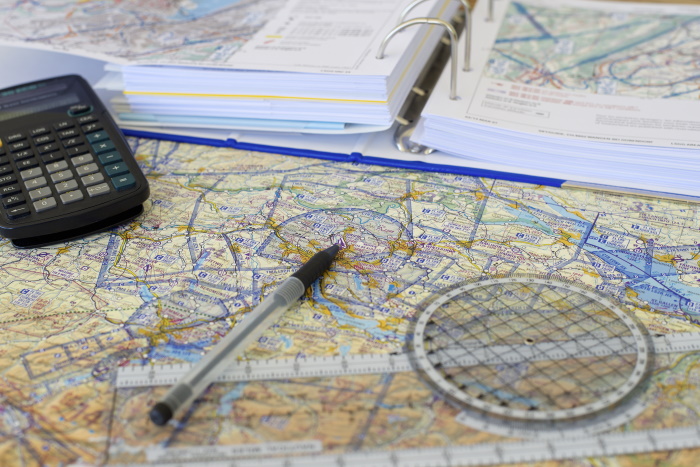General Navigation (Gen Nav) covers topics and skills you will need for flying an aircraft such as charts, plotting, great circles, temperature, heights, and speed.
Despite some thinking that modern GPS navigation has rendered this topic outdated, it is still an important topic for any pilot to learn.
A good understanding of maths is needed for this subject as well as a Navigational Computer.
This is only meant as a guide to the General Navigation subject as it applies to the Bristol Groundschool ATPL theory course.
General Navigation Topics
Below is a look at the individual topics the Bristol Groundschool ATPL course breaks General Navigation into and some of the things you’ll learn about in each topic.
Directions and Coordinates
This topic includes learning about the Earth, the poles, latitude, and longitude, as well as calculations of latitude.
Coordinates and Distance
How distance is measured on Earth, and how distances relate to latitude and longitude.
Lines on the Earth
Direction, convergency, great circles, rhumb lines and conversion angles.
Magnetism and Compasses
The Molecular theory of magnetism, magnetic fields, the Earth’s magnetism, isogonals, magnetic and compass direction.
Conic Projections
Scale and scale calculations, chart projections, distortions and usable area, great circles, rhumb lines and Lambert projection.
Mercator and Polar Stereo Projections
The polar stereographic projection, convergence, scale and Mercator’s projection.
Temperatures and Altitudes
Total air temperature (TAT), static air temperature (SAT), height, altimetry procedures and density altitude.
Glidepath Calculations and Speed
Glidepath calculations and speed, glideslopes as percentages, mach numbers and air miles versus ground miles.
Fuel Calculations
Fuel calculations, other uses of the navigational computer and distance conversions.
Triangle of Velocities and Dead Reckoning
Heading, track and drift, wind calculations, wind finding, finding head and ground speed, average wind calculation, and finding track and ground speed.
Plotting
Bearings, Q codes, relative bearings, symbols and charts and plotting distances.
Navigation Techniques
Route planning, choice of ground features, plotting the chart, line features, locating identifiable landmarks, the navigation log, tracking errors, ground speed errors and speed adjustments.
More Techniques and MDR
Calculating top of decent and top of climb position, mental DR techniques, wind components, headwind and crosswind by trigonometry.
Solar System and Time
The solar system, Kepler’s law, the solar day, the year, local time calculations, the international date line, uses of LMT, sunrise, sunset and twilight.
General Navigation Exams
The exam for General Navigation lasts 2 hours and 15 minutes. You’ll have 55 multiple-choice questions to answer during this time, with the pass rate being 75%.
The EASA exams do not allow electronic navigational computers, only the mechanical type based on a circular slide rule.
An Example of a General Navigation Exam Question
This is an example of the type of question you may have in a General Navigation exam. For more questions like this one, visit the BGSonline question bank to start revising with over 15,000+ ATPL, CPL, IR and PPL questions. Subscriptions start from £23 for one month for access to ATPL/CPL questions.
Question: On a Direct Mercator chart, a rhumb line appears as a:
A) Straight line
B) Small circle concave to the nearer pole
C) Spiral curve
D) Curve convex to the nearer pole
Click to reveal the answer
The answer is A, straight line.
On a Direct Mercator chart meridians are parallel, equally spaced, straight lines.
Therefore, a straight line track crossing the meridians will cross them at the same angle, i.e. at a constant bearing.
Constant bearing tracks are Rhumb Line Tracks.
Need Help Revising for your ATPL or CPL Exams?

Watch over 200 hours of online classroom teaching presented by our experienced instructor team, with a subscription to BGS Video Library.
BGS Video Library covers ATPL (A & H), and CPL (A & H) topics and subjects, including General Navigation.
Interested? Take a look at our webinar preview below of General Navigation – The Earth, Latitude & Longitude, Direction
Find out more about BGS Video Library
Download our Free Ebook: The Essential ATPL Student Guide to Studying and Passing your Exams

Starting your ATPL theory soon?
Check out our new ebook on how to study and pass your ATPL exams. Discover what you’ll need to know about ATPL theory including:
- What each ATPL exam includes
- What to expect from each ATPL subject
- Choosing the right ground school for you
- How to study your ATPL theory
- Note-taking techniques
- Tips leading up to exam day
CLICK HERE TO DOWNLOAD YOUR FREE EBOOK

